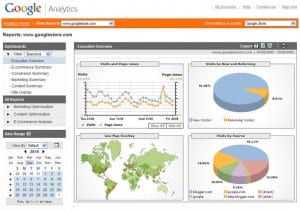A number of pages on this site have discussed various Web marketing methodologies. Web analytics is not a marketing tool but rather an analytical system providing you with the necessary insight to judge the effectiveness of your promotional efforts. It requires adding an invisible “tracking code” snippet on every Website page. This tracking code collects a voluminous amount of information about each site visitor and communicates it back to a central repository where it is aggregated for analysis and reporting.
There once were a large number of alternatives in Web analytics tools and I routinely installed one of them on almost every site I created. One of the best was Urchin which Google acquired in 2005 and has worked continuously since to improve. They named their enhanced version “Google Analytics”. This tool has unmatched capabilities and is available for free … what’s not to like? It’s the only Web analytics I’ve used and recommended for the last nine years.
What kind of information can Google Analytics provide? Let’s list a few:
- How many visitors your site received.
- The percentage of these that were new visitors versus returning visitors.
- How many Web pages, on the average, they viewed.
- The average length of time visitors stayed on your site.
- The visitor count by global location.
- The “referrer” that sent these visitors to your site (search engine, social network, one of your promotions, etc.).
- The search terms or phrases they used to find your site.
- The search terms or phrases visitors used on your site’s internal search function.
- Browsing devices (computer, tablet, mobile phone) used to access your site.
- Detailed visitor hardware and software information.
- Tracking of optional on-page events (like watching a video or filling out a form).
- Tracking of “conversions” (whatever constitutes a successful site visit to you: purchases, information requests, newsletter subscription, downloads, etc.).
- Goal tracking (did you reach the goals you set for your site).
- Tracking by each page on your site.
- The average time each site page took to load.
- The site pages visitors didn’t care for (exited your site from).
Retrieving and Viewing Your Analytics
Your Google Analytics are cloud based and can be accessed from any Web browser. Once you are logged in, you can view your Website metrics between two date ranges of your choice or elect standard periods like “this month”, “last month” or “yesterday”. From within this grouping, you can “drill-down” into literally hundreds of options like “events”, “goals”, “geographic locations”, “exit pages”, etc.
To make it even easier to keep abreast of your site activity, I typically set-up up Emailed analytics summaries on the frequency you dictate (daily, weekly, monthly). On WordPress sites, I additionally install a Google Analytics “window” that allows you to review select metrics from within your site’s “dashboard”.
Understanding and Reacting to Your Analytics
From the list above, you can see there’s substantial analytical statistics available for your review. Beyond its obvious curiosity factor, this information allows you to adjust your site content and marketing directions to move toward and ultimately achieve your business goals and objectives. I often aid clients in this review process by adding my insight and opinions.
I collaborate effectively with clients all over the world using telephone, Email and live screen sharing ... ask for a reference list. You can contact me right now at 505.750.4728 or PatRiley@DigitalPersonalities.com!



